The Port Bienville Railroad( reporting mark PBVR) is a class III railroad operating in Mississippi.
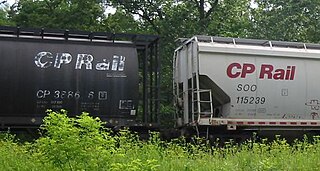
A reporting mark is an alphabetic code of two to four letters used to identify owners or lessees of rolling stock and other equipment used on certain railroad networks.

Mississippi is a state located in the southeastern region of the United States. Mississippi is the 32nd most extensive and 34th most populous of the 50 United States. It is bordered by Tennessee to the north, Alabama to the east, the Gulf of Mexico and Louisiana to the south, and Arkansas and Louisiana to the west. The state's western boundary is largely defined by the Mississippi River. Jackson, with a population of approximately 167,000 people, is both the state's capital and largest city.
All mainline rail operated by PBVR has 286,000 pound gross-weight-on-rail capability. PBVR can store up to 429 rail cars at any one time. Multi-modal warehouse and trans-load facilities are available. The multi-modal facility is located in the Gulf Coast Foreign Trade Zone (FTZ) #92 within the industrial park. A trans-loading site is available for other prime sites for bulk transfers and storage of product.
PBVR provides daily service to a Class I railroad interchange at Ansley, Mississippi. Port Bienville is located 40 miles east of New Orleans, Louisiana.
The PBVR provides switching services for various customers within their plants and for moving cars to and from off-plant site storage facilities. PBVR also offers rail car in-transit storage for customers who ship across the Gulf Coast. Its daily service provides great flexibility for storing of future shipments.
The railroad was heavily damaged by Hurricane Katrina in 2005 however repairs were made and PBVR is back in full operation.
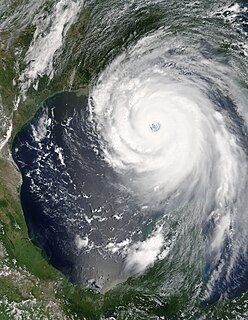
Hurricane Katrina was an extremely destructive and deadly Category 5 hurricane that made landfall on Florida and Louisiana in August 2005, causing catastrophic damage; particularly in the city of New Orleans and the surrounding areas. Subsequent flooding, caused largely as a result of fatal engineering flaws in the flood protection system known as levees around the city of New Orleans, precipitated most of the loss of lives. The storm was the third major hurricane of the record-breaking 2005 Atlantic hurricane season, as well as the fourth-most intense Atlantic hurricane on record to make landfall in the contiguous United States, behind only the 1935 Labor Day hurricane, Hurricane Camille in 1969, and Hurricane Michael in 2018.

Intermodal freight transport involves the transportation of freight in an intermodal container or vehicle, using multiple modes of transportation, without any handling of the freight itself when changing modes. The method reduces cargo handling, and so improves security, reduces damage and loss, and allows freight to be transported faster. Reduced costs over road trucking is the key benefit for inter-continental use. This may be offset by reduced timings for road transport over shorter distances.

The Wisconsin and Southern Railroad is a Class II regional railroad in southern Wisconsin and northeastern Illinois currently operated by Watco Companies. It operates former Chicago, Milwaukee, St. Paul and Pacific Railroad and Chicago and North Western Transportation Company (C&NW) trackage, mostly acquired by the state of Wisconsin in the 1980s.
Watco Companies, L.L.C. (Watco) is a transportation company based in Pittsburg, Kansas, formed in 1983 by Charles R. (Dick) Webb. Watco is composed of four divisions: transportation, mechanical, terminal and port services, and compliance. Watco is the owner of Watco Transportation Services, L.L.C. (WTS), which operates 41 short line railroads in the U.S. and Australia. It is one of the largest short line railroad companies in the United States. As of December 2018, it operated on 5,500 miles (8,900 km) of leased and owned track. Also under transportation is the contract switching the company provides service for 30 customers. That is the service that Watco originally offered before it branched out into other areas.

The New Hope Railroad (NHRR) is a shortline/heritage railroad in the state of Pennsylvania.

The California Northern Railroad is one of several Class III short-line railroad companies owned by Genesee & Wyoming, Inc. It operates over Southern Pacific Railroad (SP) tracks under a long-term lease.

The Florida Railroad Museum is a railroad museum located in Parrish, Florida. The museum operates a heritage railroad and offers round-trip tourist excursions along six miles of the former Seaboard Air Line Sarasota Subdivision in Manatee County between Parrish and Willow.

The Port of New Orleans is a deep-draft multipurpose port at the center of the world's busiest port system -- Louisiana's Lower Mississippi River. Specializing in breakbulk and container cargo, as well as passenger cruises.

The Wiregrass Central Railroad is a shortline railroad operating 19.5 miles (31.4 km) of track from a CSX Transportation connection at Waterford, near Newton, to Enterprise, Alabama via the south side of Fort Rucker. The company was initially a subsidiary of Gulf and Ohio Railways and began operations in 1987 following the purchase of the Enterprise Subdivision branch line of CSX Transportation.

The Saudi Railways Organization (SRO) is one of two state-owned companies that operates Saudi Arabia's rail network. The SRO operates a network of railways with a total length of approximately 1,380 kilometers. The network consists of two main lines. A 449 km passenger line that links Dammam with Riyadh, and a 556 km freight line that connects the King Abdul Aziz Port in Dammam with Riyadh In addition, about 373 km of auxiliary lines branch from SRO's main lines and connect some industrial and agricultural areas, and military sites, with export ports and residential areas.
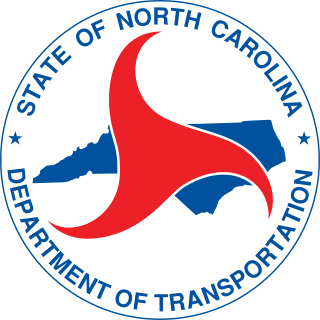
The North Carolina Department of Transportation (NCDOT) is responsible for building, repairing, and operating highways, bridges, and other modes of transportation, including ferries in the U.S. state of North Carolina.
The Belvidere & Delaware River Railway Company also known as Delaware River Railroad is a class III railroad in the United States. It was formed in 1995 when the Conrail Delaware Secondary line was purchased by the Black River Railroad System, which operates several railroad services in western New Jersey and eastern Pennsylvania. The Black River Railroad System also owns and operates the Black River & Western Railroad (BR&W). BR&W leases 10 miles of track to BDRV since 2004. Trackage purchased was a segment of the original Belvidere Delaware Railroad, later controlled by the Pennsylvania Railroad and ultimately Penn Central.

Union Station, also called the Meridian Multi-Modal Transportation Center, is an intermodal transportation center in Meridian, Mississippi. The station is located at 1901 Front Street in the Union Station Historic District within the larger Meridian Downtown Historic District, both of which are listed on the National Register of Historic Places. Consisting of a new addition and renovated surviving wing of the 1906 building, Union Station was officially dedicated on December 11, 1997. It is a center of several modes of passenger transportation, including Amtrak train service on the Norfolk Southern rail corridor, Greyhound, and other providers of bus services.
The North Carolina Global TransPark (GTP) is a 2,500 acre, multi-modal industrial/airport site in Eastern North Carolina. As an agency of the State of North Carolina, the GTP is considered a key engine for driving the economy of Eastern North Carolina. The park offers access to multi-modal transportation options: air, rail, highways, and North Carolina's two international ports. The GTP is part of an economic development initiative in eastern North Carolina intended to spur transition in the region from an agricultural base to one of skilled labor and industrial manufacturing. Industries targeted by the GTP are aerospace, defense and logistics sectors.
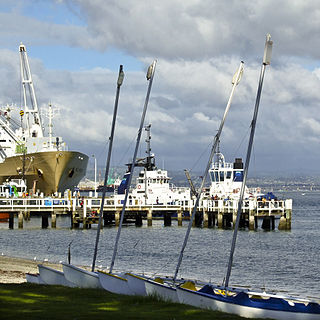
Port of Tauranga is the port of Tauranga, New Zealand. It is the largest port in the country both in terms of total cargo volume, and in terms of container throughput with container volumes exceeding 950,000 TEU's. The port is operated by Port of Tauranga Ltd. This article is about both the company and the port itself.
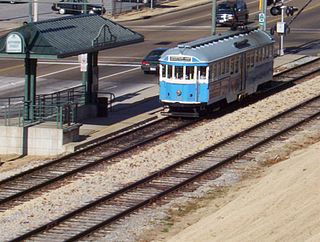
Memphis, Tennessee has developed into a major Mid-American commercial and transportation hub because of its location on the Mississippi River and a convergence of numerous rail and highway links. Four rail and highway bridges cross the Mississippi River at Memphis. In addition, Memphis International Airport has become the world's largest airfreight terminal.

The CG Railway is a terminal railroad as reported by the Association of American Railroads. The CGR is headquartered in Mobile, Alabama, and is owned and operated by a 50/50 joint venture between SEACOR Holdings and Genesee & Wyoming. The railroad operates an approximate 900-mile (1,400 km) train ferry between the Port of Mobile at Mobile, Alabama, and the Port of Coatzacoalcos in Coatzacoalcos, Veracruz. It began operations in 2000 out of Mobile, Alabama. In 2004 the railroad moved its American port to New Orleans, Louisiana. The Port of New Orleans facility was heavily damaged by Hurricane Katrina in 2005. In 2007 the Alabama State Port Authority agreed to construct a state of the art $19 million rail-ferry terminal at the Port of Mobile. The CGR connects with CSX Transportation, Norfolk Southern, BNSF Railway, Canadian National Railway, and Alabama Gulf Coast Railway all at Mobile, Alabama, and Ferrocarril del Sureste at Coatzacoalcos, Veracruz. T

The Andersons, Inc. is an agribusiness established in 1947 that began as Andersons Truck Terminal (ATT) in the 1940s for the grain industry, headquartered in Maumee, Ohio. In various phases it provided merchandising, production, and distribution of products and services to the agribusiness community, organized into multiple business groups: grain, ethanol, plant nutrients, retail, turf & specialty, and rail. The grain arm still provides grain storage and management facilities, crop insurance, commodity risk management and grain delivery services through its rail business, with a particular focus on the Eastern Corn Belt of Ohio, Indiana, Michigan, Nebraska and Illinois, through grain terminals located in those states.

The Mississippi Export Railroad (MSE) is a 42-mile shortline railroad operating in the state of Mississippi from Pascagoula to Evanston. It is the north-south corridor connecting to the Canadian National and the eas-west line of CSX in Pascagoula. MSE also connects to the NS in Mobile, AL, and Hattiesburg, MS and KCS in Jackson, MS, through haulage agreements. We also have access to the Terminal Alabama State Docks - and the Port of Pascagoula through reciprocal switch. These connections and their alliances link the Gulf of Mexico to all points of the continent.

The California Car is the first generation of intercity railcars owned by the California Department of Transportation (Caltrans) and operated by Amtrak under the Amtrak California brand on intercity corridor routes in Northern and Central California. The cars were built in the mid-1990s for the Caltrans Division of Rail by Morrison-Knudsen. The cars are similar to Amtrak's Superliner, but original in design to provide rolling stock suitable for California intercity services up to six hours, with more frequent stops than most other Amtrak routes. All cars were overhauled by Alstom at its Mare Island facility between 2009 and 2012.



















